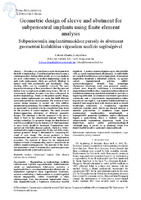Geometric design of sleeve and abutment for subperiosteal implants using finite element analysis

View/
Metadata
Show full item record
URI
Collections
- Bánki közlemények [136]
Abstract
Nowadays, we experience a rapid development is the field of implantology. Dental implant insertion became a routine procedure during which, mostly screw-type implants are used. Achievements in modern implantology result in such tooth replacements which are perfectly identical to natural teeth both aesthetically and functionally. Thus, chewing ability can be completely restored. The most important advantage of these procedures is that they prevent further bone resorption in neighbouring tissues. The use of custom-made implants becomes even more widespread in modern implantology. Thanks to the patient-specific design, various dental replacements are made that fulfil different needs and expectations of each patient. The creation of these custom design implants is carried out with additive manufacturing technology. This additive technology provides an opportunity for patients who have insufficient bone tissue for the insertion of conical implants. This study presents denture-supporting abutments of different geometric designs. The abutment is directly connected to the sleeve, which is fixed to the subperiosteal implant with micro-welding technology. In geometric design, the distribution of axial forces resultant from the denture is of vital importance as stress levels should be decreased. Examinations were carried out with finite element analysis, which is a widely-used method in engineering practice. By the end of this study, optimal geometric design is determined by comparing the result of each design. The chosen geometry is then implemented into practice and used for the implantation procedure. The material of choice for the subperiosteal implant is Grade 23 titanium alloy, and it is created with an additive manufacturing process. The material of the sleeve and abutment is Grade 5 titanium alloy, and these parts are manufactured with a subtractive process.
- Title
- Geometric design of sleeve and abutment for subperiosteal implants using finite element analysis
- Author
- Kulcsár Klaudia
- Kónya János
- xmlui.dri2xhtml.METS-1.0.item-date-issued
- 2019
- xmlui.dri2xhtml.METS-1.0.item-rights-access
- Open Access
- xmlui.dri2xhtml.METS-1.0.item-language
- ENG
- xmlui.dri2xhtml.METS-1.0.item-format-page
- 29-34. p.
- xmlui.dri2xhtml.METS-1.0.item-subject-oszkar
- implant, subperiosteal implant, finite element analysis, sleeve, abutment
- xmlui.dri2xhtml.METS-1.0.item-description-version
- Kiadói változat
- xmlui.dri2xhtml.METS-1.0.item-identifiers
- MTMT: ISSN 2560-2810
- xmlui.dri2xhtml.METS-1.0.item-other-containerTitle
- Bánki Közlemények
- xmlui.dri2xhtml.METS-1.0.item-other-containerPeriodicalYear
- 2019
- xmlui.dri2xhtml.METS-1.0.item-other-containerPeriodicalVolume
- 2
- xmlui.dri2xhtml.METS-1.0.item-other-containerPeriodicalNumber
- 1
- xmlui.dri2xhtml.METS-1.0.item-type-type
- Tudományos cikk
- xmlui.dri2xhtml.METS-1.0.item-publisher-university
- Óbudai Egyetem
